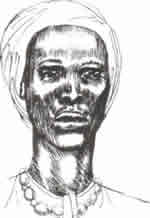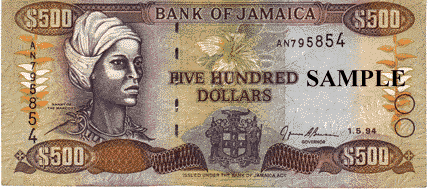Hi varandaites. It's here; unveiling the Spotlight Series. The purpose of these series is to bring a bit of historic as well as present-day culture of our beloved Jamaica to wi likkle Verandah. Bandi and I don't claim to be experts in this field but with some research and help from you we will all be enlightened. We must give a big thank you to Ackee who actually started this quite sometime ago and we decided to pick up the baton and keep it going. With that said, we hope you enjoy and again if there are any suggestions you may have please feel free to PM Bandi or myself.
**************************************************


Nanny was a leader of the Maroons at the beginning of the 18th Century. In fact, she is described as a fearless Asante warrior who used militarist techniques to fool and beguile the English. She was known by both the Maroons and the British settlers as an outstanding military leader who became, in her lifetime and after, a symbol of unity and strength for her people during times of crisis.
She was particularly important to them in the fierce fight with the British during the First Maroon War from 1720 to 1739. Although she has been immortalized in songs and legends, certain facts about Nanny, (or Granny Nanny, as she was affectionately known) have also been documented.
Both legends and documents refer to her as having exceptional leadership qualities. She was a small wiry woman with piercing eyes. Her influence over the Maroons was so strong that it seemed to be supernatural and was said to be connected to her powers of obeah. She was particularly skilled in organizing [sic] the guerrilla warfare carried out by the Eastern Maroons to keep away the British troops who attempted to penetrate the mountains and overpower them.
Her cleverness in planning guerrilla warfare confused the British and their accounts of the fights reflect the surprise and fears which the Maroon traps caused among them. Beside inspiring her people to ward off troops, Nanny was also a type of chieftainess or wise woman of the village, who passed down legends and encouraged the continuation of customs, music and songs that had come with the people from Africa and that instilled in them confidence and pride.
Her spirit of freedom was so great that in 1739, when her brother Quao signed the second Treaty (the first was signed by Cudjoe [also her brother] for the Leeward Maroons a few months earlier) with the British, it is reported that Nanny was very angry and in disagreement with the principle of peace with the British which she knew meant another form of subjugation.
There are many legends about Nanny among the Maroons. Some even claim that there were several women who were leaders of the Maroons during this period of history. But all the legends and documents refer to Nanny of the Maroon War as the most outstanding of them all, leading her people with courage and inspiring them to struggle to maintain that spirit of freedom, that life of independence, which was their rightful inheritance.
Like the heroes of the pre-Independence era, Nanny too met her untimely death at the instigation of the English sometime around 1734.
Yet, the spirit of Nanny of the Maroons remains today as a symbol of that unconquerable desire that will never yield to captivity.
source
**************************************************


Nanny was a leader of the Maroons at the beginning of the 18th Century. In fact, she is described as a fearless Asante warrior who used militarist techniques to fool and beguile the English. She was known by both the Maroons and the British settlers as an outstanding military leader who became, in her lifetime and after, a symbol of unity and strength for her people during times of crisis.
She was particularly important to them in the fierce fight with the British during the First Maroon War from 1720 to 1739. Although she has been immortalized in songs and legends, certain facts about Nanny, (or Granny Nanny, as she was affectionately known) have also been documented.
Both legends and documents refer to her as having exceptional leadership qualities. She was a small wiry woman with piercing eyes. Her influence over the Maroons was so strong that it seemed to be supernatural and was said to be connected to her powers of obeah. She was particularly skilled in organizing [sic] the guerrilla warfare carried out by the Eastern Maroons to keep away the British troops who attempted to penetrate the mountains and overpower them.
Her cleverness in planning guerrilla warfare confused the British and their accounts of the fights reflect the surprise and fears which the Maroon traps caused among them. Beside inspiring her people to ward off troops, Nanny was also a type of chieftainess or wise woman of the village, who passed down legends and encouraged the continuation of customs, music and songs that had come with the people from Africa and that instilled in them confidence and pride.
Her spirit of freedom was so great that in 1739, when her brother Quao signed the second Treaty (the first was signed by Cudjoe [also her brother] for the Leeward Maroons a few months earlier) with the British, it is reported that Nanny was very angry and in disagreement with the principle of peace with the British which she knew meant another form of subjugation.
There are many legends about Nanny among the Maroons. Some even claim that there were several women who were leaders of the Maroons during this period of history. But all the legends and documents refer to Nanny of the Maroon War as the most outstanding of them all, leading her people with courage and inspiring them to struggle to maintain that spirit of freedom, that life of independence, which was their rightful inheritance.
Like the heroes of the pre-Independence era, Nanny too met her untimely death at the instigation of the English sometime around 1734.
Yet, the spirit of Nanny of the Maroons remains today as a symbol of that unconquerable desire that will never yield to captivity.
source


Comment